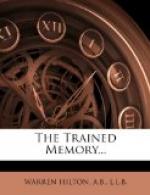These instances of the action of the Law of Recall illustrate but one phase of its activity. They show simply that groups of ideas are so strung together on the string of some common element that the activity of one “group” in consciousness is apt to be automatically followed by the others. But the law of association goes deeper than this. It enters into the activity of every individual group, and causes all the elements of every group, ideas, emotions and impulses to muscular movements, to be simultaneously manifested.
[Sidenote: Prolixity and Terseness]
There is no principle to which we shall more continually refer than this one. Our explanation of hay fever a moment ago illustrates our meaning. Get the principle clearly in your mind, and see how many instances of its operation you can yourself supply from your own daily experience.
So far as the mere linking together of groups of ideas is concerned, this classifying quality is developed in some persons to a greater degree than in others. It finds its extreme exemplar in the type of man who can never relate an incident without reciting all the prolix and minute details and at the same time wandering far from the original subject in pursuit of every suggested idea.
[Sidenote: The Law of Contiguity]
Law II. Similarity and nearness in time or space between two experiential facts causes the thought of one to tend to recall the thought of the other.
This is the Associative Law of Contiguity considered from the standpoint of recall. The points of contiguity are different for different individuals. Similarities and nearnesses will awaken all sorts of associated groups of ideas in one person that are not at all excitable in the same way in another whose experiences have been different.
Law III. The greater the frequency and intensity of any given experience, the greater the ease and likelihood of its reproduction and recall.
[Sidenote: Laws of Habit and Intensity]
This explains why certain groups in any complex are more readily recalled than others—why some leap forth unbidden, why some come next and before others, why some arrive but tardily or not at all.
This is how the associative Laws of Habit and Intensity affect the power of recall.
* * * * *
[Sidenote: Applications to Advertising]
There is no department of business to which the application of these Laws of Recall is so apparent as the department of advertising. The most carefully worded and best-illustrated advertisement may fail to pay its cost unless the underlying principles of choice of position, selection of medium and size of space are understood. The advertisers in metropolitan newspapers and magazines of large circulation are the ones who have most at stake. But whatever the field to be reached, it is well to bear in mind certain facts based on the Laws of Recall that have been established by psychological experiment.




